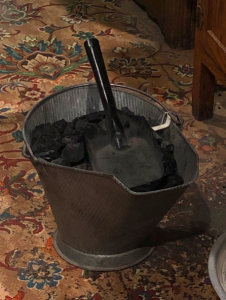The Centrepiece of the Home
Date / May 27, 2023
For many families across generations, food and the process of cooking have been an integral aspect of the family dynamic and traditions. As technology advances and the need for accessibility rises, the methods in which these practices are applied have evolved and will continue to change. This is the same as when European settlers first arrived in Alberta. The taming of fire and the creation of the stove have been a prized centrepiece that has endured generations of change. Historically, it was customary to cook over an open hearth or a centralized fire, but this posed risks to the women who did the cooking and the family as a whole; sparks could ignite their flammable homes, and people could fall into the fire. Despite the dangers, it was understandable that as the cook stove gained popularity, many people yearned for the open hearth. Mostly men romanticized and sentimentalized the open fire of the past, reminiscing more the social benefits of sitting around the fire while the matriarch prepared meals (Peterat, 2019). However, the technologically advanced cook stove was a better option for both effort and safety reasons.
The cook stove has often been credited to Benjamin Franklin with his invention of the Franklin Stove in 1742; however, this stove was more of an auxiliary fireplace for heat rather than a true cooking stove. In the 1790s Sir Benjamin Thompson (Count von Rumford) invented the stove specifically designed for cooking, commonly referred to as a Kitchen Range. Count Rumford was an expert in heat study and, “his investigations of heat overturned the theory that heat is a liquid form of matter and established the beginnings of the modern theory that heat is a form of motion,” (Britannica, 2023). The modernization of cookstoves is integral to understanding the type of lives that many European settlers in Western Alberta had lived. For example, the stove on display in NCVM’s Home display is a surviving example of how sturdy these devices needed to be, as they truly were the centrepiece of the home.
The stove featured here is made of wrought iron, which is similar to but distinct from cast iron. Both processes require heating, melting, and working iron; however, cast iron is poured into a mould and allowed to cure, whereas wrought iron is physically manipulated using tools. While cast iron is stronger and non-malleable, wrought iron was favoured for more intricate designs as it can be heated and worked. Neither one is superior to the other as both are essential for their intended purposes, such as a cast iron pan or a wrought iron fence (Reliance Foundry, 2023).

Above is an assortment of tools that rely on the stove’s heat and functionality to work. Shown from left to right: A kettle for heating water to enjoy afternoon tea, several examples of irons to be heated on the stove and pressed into clothes for a sharp appearance, and an assortment of pots for heating water for cleaning or cooking. How does one heat up a stove in rural Alberta with few trees? For many people, coal (shown below) was the best option because it burned long and hot and was more readily accessible (and more affordable) than lumber (Bock, 2021).

The stove is by far one of the most essential parts of survival, even though it only represents one aspect of the complex lives of the early European settlers in Western Alberta. From heat and warmth during long, cold winters, to warming water for maintaining a standard of cleanliness, and most importantly, preparing warm, home-cooked meals that many people remember and desire even today, the stove was indeed the centre of the home.
Credits:
Photos taken by Autumn Waddington.
Edited by Laurie Harvey, Executive Director/Curator for the Nose Creek Valley Museum.
Artifacts provided by the generous donors and associates of the Nose Creek Valley Museum.
Bibliography:
Bock, Gordon. “The History of Old Stoves,” Old House Online. Updated July 13th 2021.
https://www.oldhouseonline.com/kitchens-and-baths-articles/kitchen-appliances/history-o
f-the-kitchen-stove/
Editors of Encyclopaedia of Britannica. “Sir Benjamin Thompson, count von Rumford:
American-British Physicist.” Updated March 22nd 2023.
https://www.britannica.com/biography/Sir-Benjamin-Thompson-Graf-von-Rumford
Peterat, Linda. “Cook Stove Revolution of the 1800s.” BC Food History. July 8th 2019.
Reliance Foundry. “Ask a Metallurgist: Wrought Iron vs Cast Iron.” Accessed May 18th 2023.
https://www.reliance-foundry.com/blog/difference-cast-iron-wrought.